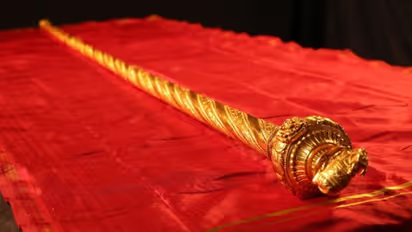New Parliament to showcase golden sceptre that Nehru received during transfer of power from British

Synopsis
The golden sceptre will be showcased in the new Parliament building.
India's new Parliament will revive the glory of the Sengol (Golden Sceptre) that "went into oblivion" after the handover of power by the British to free India, Union Home Minister Amit Shah said.
The golden sceptre will be showcased in the new Parliament building.
On the night of August 14, 1947, around 10:45 pm, Pandit Nehru accepted the Sengol (golden sceptre) specially brought from Tamil Nadu. He accepted it as a representation of liberation from the British rule. Dr Rajendra Prasad, who later became India's first president, was present on the occasion.
The Story of the Sengol
Lord Mountbatten was deputed as Viceroy to facilitate the transfer of power. He asked Pandit Nehru about the cultural symbol that should be used as a representation of the transfer of power. Nehru sought time to respond. He took the matter to C Rajagopalachari, who studied multiple historic books and informed Nehru about the Sengol.
Pandit Nehru accepted the Septor sent by the head of the Thiruvaduthurai Mutt Sri La Sri Ambalavana Desika Swamigal and that became the symbol of the transfer of power from Britishers to India. The golden sceptre was studded with jewels and was worth about Rs 15000 in that period.
The seer sent his representative Sri La Sri Kumaraswamy Thambiran along with a delegation in a special aircraft arranged by the government.
The sceptre was first handed over to Lord Mountbatten, who returned the sceptre. Following this, a purification ceremony was carried out by Sri La Sri Kumaraswamy Thambiran. He then handed over the sceptre to Pandit Nehru, smeared ashes on his forehead, and garlanded him. The golden sceptre from the Chola dynasty was taken to the Constituent Assembly Hall in a procession accompanied by 'nadaswaram' of Adinam Vidwan TN Rajaratnam Pillai.
The Union Home Minister said that after the event, the Sengol vanished from public view. However, "the new Parliament will reflect India's rich legacy," Amit Shah said.
Shah said that the transfer of power is not merely a handshake or signing a document and that it must remain connected with local traditions keeping in mind modern needs.
"Sengol represents the same feeling that Jawaharlal Nehru felt on August 14, 1947," he said.
The Home Minister said that the new Parliament building is an example of Prime Minister Narendra Modi's far-sightedness. He said the Prime Minister will honour 7,000 workers (shram yogis) at the inauguration. Shah said invitations for the inauguration of the new Parliament Building were sent to all political parties who were free to act according to their wisdom.
Stay updated with the Breaking News Today and Latest News from across India and around the world. Get real-time updates, in-depth analysis, and comprehensive coverage of India News, World News, Indian Defence News, Kerala News, and Karnataka News. From politics to current affairs, follow every major story as it unfolds. Get real-time updates from IMD on major cities weather forecasts, including Rain alerts, Cyclone warnings, and temperature trends. Download the Asianet News Official App from the Android Play Store and iPhone App Store for accurate and timely news updates anytime, anywhere.